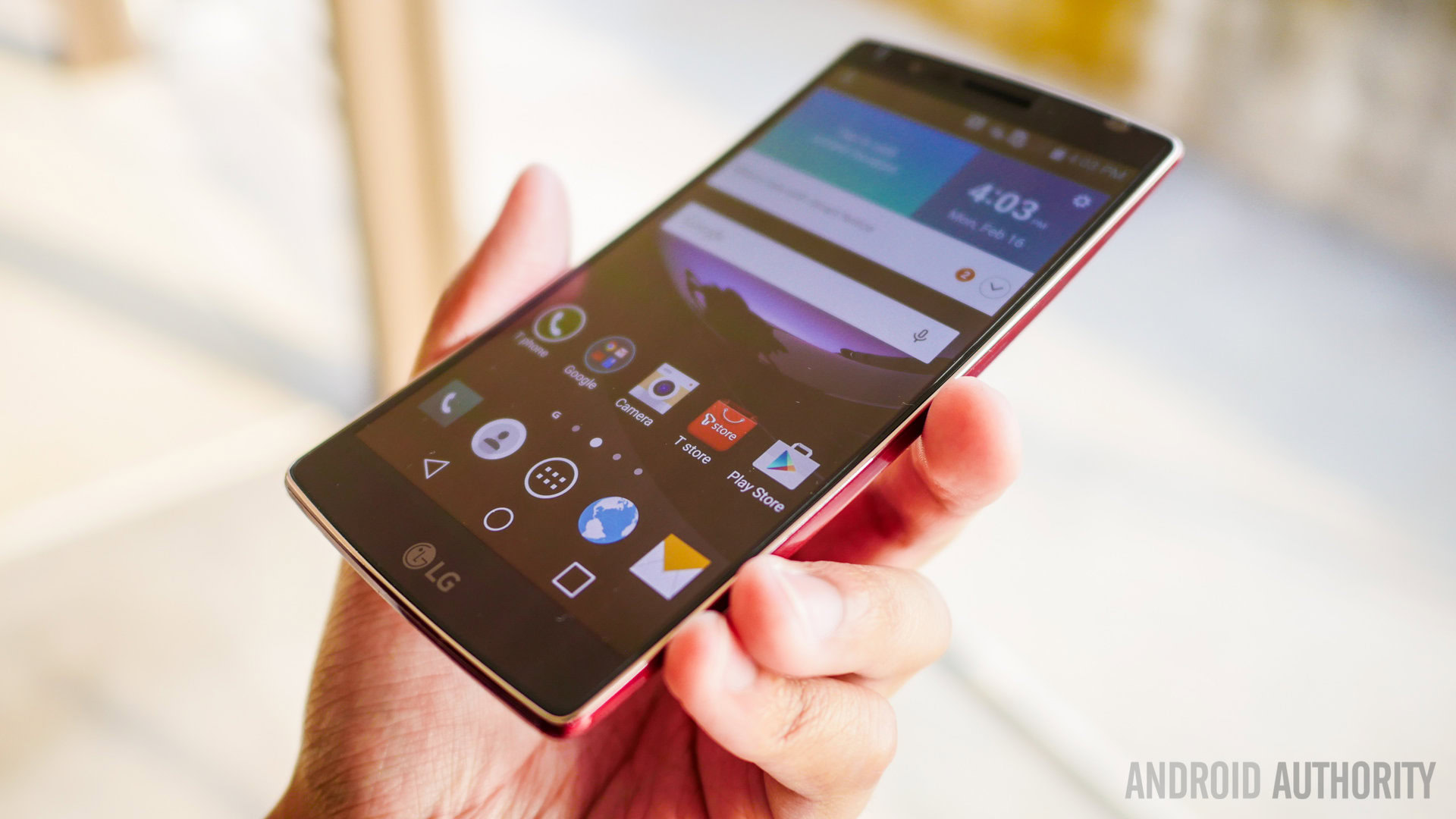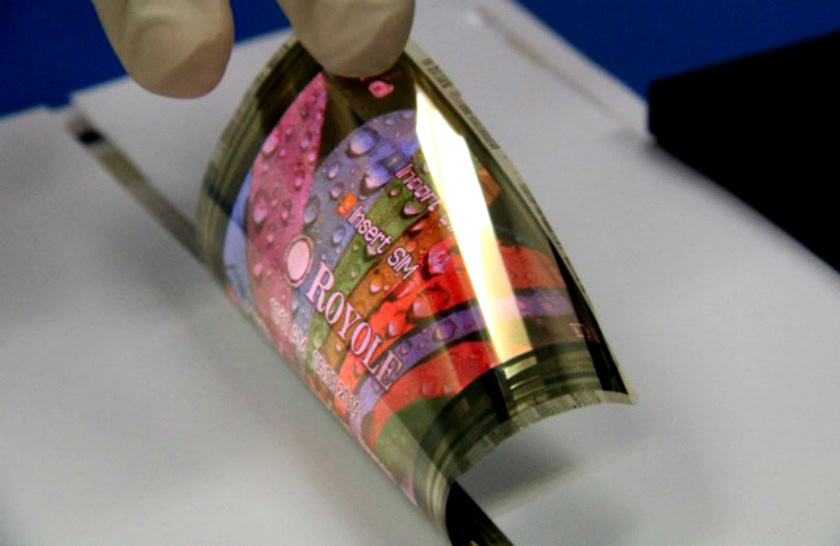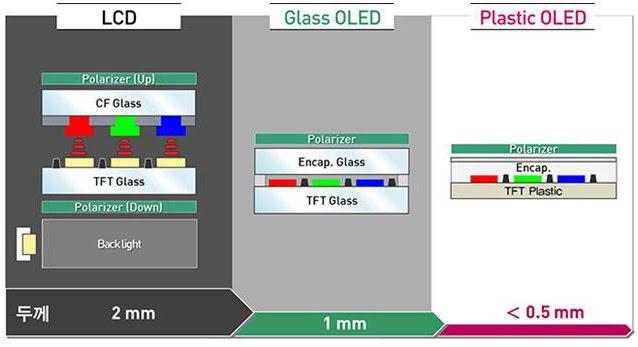Affiliate links on Android Authority may earn us a commission. Learn more.
Plastic OLED is about to come back in a big way
Published onFebruary 16, 2018

Who remembers the phone pictured above? It’s the LG G Flex 2, the second and last phone in LG’s experimental Flex range, which offered an interesting ergonomic curved display design and a self-healing back. Although the average consumer is now probably quite familiar with Samsung’s edge AMOLED display, LG was ahead of the curve with the Flex series, which made its debut in 2013 around the same time as Samsung’s now little-remembered Galaxy Round.
The technology enabling the Flex’s unique look is called Plastic OLED (POLED), and as the name implies, the flexible nature of the panels comes from the use of a plastic rather than glass substrate. One of the benefits being that plastic is thinner and more flexible than glass, allowing for a wider range of form factors. Unfortunately since the G Flex 2 in 2014, very few devices have made use of this interesting panel technology. Its malleable properties have seen it put to use in a few smartwatches since, but that’s about it.

Within the next two years, LG Display says that will have the capacity to produce 120 million 6-inch POLED smartphone displays per year.
However, plastic OLED looks set to make a major comeback, as LG Display is investing heavily in additional production capabilities that will come online in the next two years. According to LG Display’s latest earnings report, the company states that it is expanding POLED production capacity by 30,000 input sheets per month, giving the company a total capacity of 65,000 using its 6th generation lines in Paju and Gumi.
The company’s Gen 4.5 line in Paju is currently producing 22,000 sheets per month, which will be followed by the start of its Gen 6 (1,500 mm x 1,850 mm) Gumi plant sometime in Q3 2017 for a further 15,000 per month. The Gen 6 line in Paju is then expected to come online in H2 2018, adding a further 15,000 per month. LG Display calculates that this will be enough capacity to churn out 120 million 6-inch smartphone displays per year, enough to cater for a very popular handset range.

When we spoke to LG Display during a media tour in Paju, the company stressed that its technology has been ready for quite some time, and is as good as competing products on the market already. However, sales have been held back by a lack of client demand and production capabilities. With LG Display expecting the market to demand some 120 million POLED units in 2017 and 370 million by 2020, the company is investing KRW 5 trillion into its 6th generation line in Paju, which follows KRW 7.8 trillion of other recent investments into OLED.
With that in mind, LG Display’s roadmap could cater for a OLED V30 launch in Q3, but perhaps a G7 launch next year would give the company more time to build up stock for a major global release. Rumors that LG OLED panels are being bought up for the iPhone 8 and possibly Google’s Pixel 2 would complicate LG’s own smartphone plans though. LG Display won’t be running at full capacity until late 2018 and so is unlikely to fill orders for three separate flagship launch windows so soon, even if Apple buys most of its panels elsewhere.
The V30, iPhone 8, and Pixel 2 are all rumored to feature OLED, but LG Display's production capabilities are only just ramping up. Will there be enough panels?
While LG Display obviously backs its latest mobile panel technology, and LG’s OLED is proving very impressive in the TV space, the company’s early flexible mobile displays didn’t quite attract the same praise.
One of the criticisms leveled at the G Flex series was its low display resolution at the time. LG’s plastic OLED panels sported 720p and then 1080p resolutions at a time when other flagship phones were moving on to 1080p and then QHD respectively. This made the phones a hard sell, even though the displays themselves looked pretty good (notwithstanding the original G Flex’s ghosting issues).
During our tour at Paju, we came across some plastic OLED smartphone and smartwatch prototype displays in the showroom. These models showed off a design that was much closer to Samsung’s edge display technology than the G Flex curve. More importantly though, these panels were boasting 1080p and QHD display resolutions, meaning that LG now appears to be able to manufacture higher resolution POLED panels without issue. This is certainly good news for the flagship market and suggests that Samsung may soon have some serious OLED competition on its hands.
Plastic OLED does have its own benefits over the glass variant that we’re more familiar with too. Perhaps the biggest is durability. The slightly flexible nature of the display offers some additional shock absorbance over glass, which means a slightly smaller chance of cracking your panel if you happen to drop your phone and a longer lifetime from stress fractures. Plastic OLED is also up to half as thin as glass OLED. This enables manufactures to build slightly thinner devices, and we all know how much of a premium is placed on freeing up space in today’s smartphones.
As we mentioned, the flexible substrate makes plastic OLED suitable for a wide range of other form factors too. Wearables have already made good use of the technology, but the automotive industry will likely turn out to be a much bigger and important market, with use cases ranging from dashboards to infotainment systems. We saw a few examples of these form factors in Paju too, so vehicular applications are clearly already on LG’s radar.
POLED (and OLED in general) is the future of display tech
When it comes to production capabilities, Samsung still has a major head start over LG Display, as far as OLED is concerned, but that’s going to narrow over the next year or so. This doesn’t necessarily mean that LG Display is going to be selling all of its POLED panels to LG Electronics for smartphones though. We may see any number of third party manufacturers opt to pick up panels from LG Display, with Apple and Google both being tipped as major buyers and investors already.
Most importantly for us consumers, either way it means that we’re likely to see more OLED panels inside smartphones, along with all the benefits that this technology brings in terms of a wider color gamut, superior contrast, and HDR playback capabilities. Not to mention all the sleek and interesting form factors that manufacturers can flex POLED panels into.
Plastic OLED looks set to come back in a big way over the next 12 to 18 months, and could well end up inside your next smartphone.